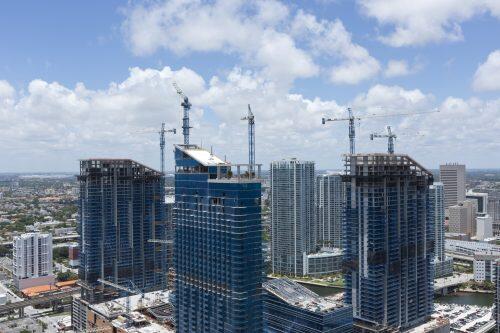
From left to right: Melissa Pallett-Vasquez, Jay Sakalo, Suzanne Amaducci-Adams, Al Dotson Jr., Joy Spillis Lundeen, John Sumberg
Once known mainly for its sandy beaches, balmy climate and laid-back attitude, South Florida has become a diverse and dynamic commercial center, attracting never-before-seen business and wealth migration from around the world. This transformation may seem abrupt, but the foundations have been in the works for nearly four decades. With growth expected to continue, it’s paramount to understand where Miami came from in order to learn what it will look like in the future. To learn about this region’s fascinating past and promising future, we spoke with the team at Bilzin Sumberg – a law firm with a hand in every aspect of South Florida’s economic development, from real estate development, infrastructure, transit and mobility, to retail and hospitality, financial services, technology, healthcare, and higher education. As a one-stop-shop for out-of-state and foreign investors and developers seeking entry into South Florida’s booming economy, Bilzin Sumberg is perfectly positioned to help tell the region’s story.
An ’80s revival goes global
“The story of South Florida’s growth reflects the evolution of Miami as an international city,” said Bilzin Sumberg chairman John Sumberg, whose work on countless complex real estate transactions over his 40-year-long career helped revitalize Miami’s skyline. “When I arrived in 1959, Miami was still a small city with limited influence beyond South Florida.” This all began to change in the 1980s when a wave of architectural restoration washed over Miami Beach’s run-down Art Deco district. Thanks in part to the success of the hit TV show “Miami Vice,” Miami-Dade was illuminated by an international spotlight, and wealth from around the world began pouring into the formerly sleepy region. Six new office buildings went up in Miami’s Brickell Financial District, which began a cycle of development that ultimately attracted new high-end residential buildings for white-collar workers as well as shopping, fine dining, and cultural attractions to keep them entertained.

Downtown Brickell – Miami, FL
The 1990s saw infrastructure improvements that facilitated this office and residential development, which spread from Downtown Miami and Brickell into surrounding neighborhoods. Simultaneously, investment poured in from Latin America, and the region’s economy became intertwined with international markets. Soon, investors from Europe and Asia joined the tide, turning Miami and South Florida into an international gateway for companies and capital entering the United States, dramatically improving “the quality, diversity and sophistication of the companies and investors putting capital into South Florida,” according to Sumberg.
Lower taxes, higher quality of life
Another surge of migration and investment kicked off in 2017 when changes to state and local tax (SALT) deductions gave Florida a distinct advantage over many states by lowering residents’ tax burden even further. With the SALT changes, moving to Florida was no longer merely an excuse to live closer to world-class beaches and iconic golf courses; it was good business.

Miami Worldcenter, Florida
Within the state, the Miami area’s depth of business and investment opportunities attract more than its fair share of immigrants. “Nearly 1,000 people are moving to Florida each day,” said Nitin Motwani, managing partner of Miami Worldcenter and Merrimac Ventures, “and Miami and South Florida are capturing much of that inbound migration.” Of course, the area’s incredible quality of life contributes to its pull, attracting new residents drawn to its warm weather, the variety of the region’s cultural institutions and its robust economy.
“Florida’s tax climate and the benefits businesses receive have been a large draw. Beyond the financial benefits of relocating to Florida, a major catalyst for this migration is the overall lifestyle the state provides to employees.
In Miami specifically, the arts and culture scene and warm weather have established the city as an immensely desirable location for those relocating. We are especially seeing more tech and finance-focused companies coming to the area, explained Ryan Shear, managing partner of New York-based PMG, a national investment, development and asset management firm.
Miami’s growth isn’t a coincidence; the City and County governments have worked tirelessly to facilitate new ventures and create a welcoming business environment while also addressing some of the County’s biggest needs such as infrastructure, affordable housing, and public education. Government officials’ efforts to court new business created a snowball effect, with business leaders evangelizing the region’s benefits to their peers and fueling the cycle of in-migration, investment and infrastructure improvement.
“The City of Miami’s Mayor Suarez has done a terrific job boosting the region and meeting with business leaders to garner interest and relocations to the area,” said Matthew Thomson, senior development associate at AMLI Residential, whose real estate development and management firm entered the South Florida market nine years ago as they consolidated their Midwest portfolio to expand into coastal, growth markets.
Pandemic opportunities
When the Covid-19 pandemic freed many workers from their ties to physical offices, they began to eye South Florida as the perfect place from which to work remotely. “Florida was the only place to go last year,” said Suzanne Amaducci-Adams, head of Bilzin Sumberg’s real estate practice, which is recognized as one of the largest and most active real estate law practices in the state with more than 40 attorneys. Amaducci-Adams and her team have expertise across all asset classes, including office, retail, industrial, hospitality, marina, condominium, multi-family, P3s, mixed-use, affordable housing, and self-storage.
Before the pandemic, people didn’t go to the Keys to work, she said. Now, Miami neighborhoods including Edgewater, Wynwood, Bal Harbour and North Miami have seen massive surges in residential development, spurred in part by the influx of workers looking to live the South Florida live-work-play lifestyle.
These areas have doubtless benefited from the increase in remote workers, a trend kicked off by the pandemic. “People started to realize they didn’t need to be face-to-face in NYC to close a transaction,” said Bilzin Sumberg Corporate, Finance & Restructuring practice group leader Jay Sakalo, who represents a number of debt funds and other direct lenders eying the Florida market for investment opportunities. “COVID was the fire that caused people to look at South Florida for other reasons than relaxation and taxes.”
Seeing the advantages of Miami’s tropical climate and growing workforce, many companies in the tech and finance industries have moved their headquarters to South Florida in the pandemic era. At the same time, South Florida has begun implementing further infrastructure improvements to meet the growing need to connect new residential developments with offices and other regions across the state. One example is the recent expansion of the Brightline high-speed rail system, which connects points along the state’s southern Atlantic Coast with farther-flung regions like the Orlando area.

Brightline (Inter-city Rail) Connectivity from Miami to West Palm Beach, Florida
Brightline will connect the state like never before, said Brightline’s president, Patrick Goddard. Over an eight-year period, Brightline’s corridor between Miami and Orlando will result in $6.4 billion in economic impact and over 10,000 jobs.
“Businesses can now take a look at recruiting talent from all over the state and not only in their backyards,” said Al Dotson, Jr., Bilzin Sumberg’s managing partner. A key pioneer in Florida’s public-private partnership arena, Dotson counsels leading companies through contract negotiations for the development of public infrastructure and the government procurement process, and through the bid protest phase. Through his work, Dotson has helped turn Florida into an international tourist destination.
Among other work, Dotson and his team were instrumental in helping bring to fruition recent additions like the Miami Dolphin’s stadium modernization and the Spring 2022 Miami Grand Prix Formula 1 race to be staged at the Miami Dolphins’ Hard Rock Stadium, a project that was shepherded through numerous legal obstacles by seasoned trial lawyer Melissa Pallett-Vasquez. The race is expected to result in a positive economic impact of over $400 million net new output for the South Florida economy each year, and the creation of over 4,000 new jobs.
Plotting a course on the rising tide
With so much growth and immigration, navigating South Florida’s flourishing business environment has come to require a local guide with institutional knowledge about the area’s history as well as its present. While the opportunities certainly outweigh the risks, finding a team that can preempt any major missteps has become ever more crucial as development booms. Bilzin Sumberg’s construction law practice has grown with South Florida, accruing decades of experience that clients can leverage when entering the market.

Brickell Avenue, Miami, Florida
Last year, attorney Joy Spillis Lundeen and a team of seven acclaimed construction law attorneys joined Bilzin Sumberg, further bolstering the firm’s statewide capabilities representing owners and developers in all phases of real estate development. Joy and her team run seminars for new clients that introduce them to the ins and outs of South Florida’s construction and development environment. “It only takes one project ending up in dispute and incurring the cost of the exorbitant litigation fees to feel that the money spent in upfront legal counsel is well spent,” Lundeen told us.
In many ways, the story of South Florida and the story of Bilzin Sumberg are one and the same. “Our firm has expanded alongside the growth of South Florida over the past two decades,” said John Sumberg. As South Florida’s business environment blossomed, so did the firm’s range of services — from facilitating inbound investment and transacting significant financing deals on behalf of developers and joint ventures, to resolving complex domestic and international contractual disputes, mortgage repurchase demands, large scale real property and foreclosure disputes, and class actions – the team is able to leverage its expertise to meet the growing needs of its clients at this pivotal moment. With each new practice area, Bilzin Sumberg’s team of experts has grown, creating a symbiotic relationship between the firm and South Florida’s booming economy. Their shared history has given the firm a depth of knowledge and experience that keeps it on top of emerging trends in the Miami area, which in turn helps it provide their clients with the best counsel possible.
Next month, we’ll speak with the Bilzin Sumberg team again to get their read on the most exciting projects and trends that are shaping South Florida’s future. In the meantime, head over to the firm’s website to learn more about how they can help you make the most of your South Florida investments.

